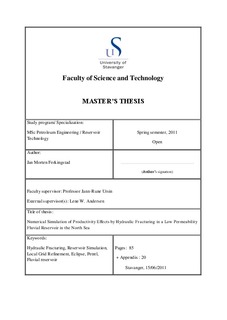| dc.description.abstract | A simulation study was performed on a recently discovered oil field. The operator is Talisman Energy, and the reservoir is complex in terms of disconnected fluvial channels, surrounded by a large majority of shale. The company was evaluating hydraulic fracturing of horizontal wells as a possible development strategy. Therefore, a simulation study was needed in order to estimate the increment in production by fracturing and to decide whether this field should be developed or not. The decision was made to numerically represent hydraulic fractures in the simulator using fine grid blocks, called Local Grid Refinement (LGR).
By using a small sector of the field reservoir model, two parallel horizontal wells were studied, one injector and one producer. Five scenarios were simulated where the aim was to get an understanding of how hydraulic fracturing could be optimised in the reservoir.
The first four scenarios studied two fractures in order to investigate the optimal distance between them, in terms of oil production, water breakthrough and sweep area. The position of the fractures was varied relatively in both wells and in one well only. The results indicated that there exist an optimal distance in the reservoir in regions of relatively equal permeability, but this distance is severely affected by flow barriers as shale and faults. The permeability variations, however, had less effect than expected. The main conclusion was that the optimal fracture setting varies throughout the reservoir. In general, fractures should not be placed too close to each other in order to avoid early water production, due to strong fracture interference. In addition, supporting fractures should be placed on the same side of a fault, sealing or not sealing, since this affects the communication.
The fifth and final scenario applied the conclusions from the other scenarios to optimise the multiple fracture placements in the two wells. Three transverse hydraulic fractures were placed in each well in order to give a realistic production estimate for one well couple. The results showed an increase in production, compared to a non-fractured case, of 400 000 Sm3, which corresponded to 33% enhancement. In addition, the importance of high early production was identified, as the fracture performance dropped rapidly within the first years.
Uncertainty in the results exists, but hydraulic fracturing of parallel horizontal wells can severely improve the recovery in fluvial dominated reservoirs. | no_NO |
